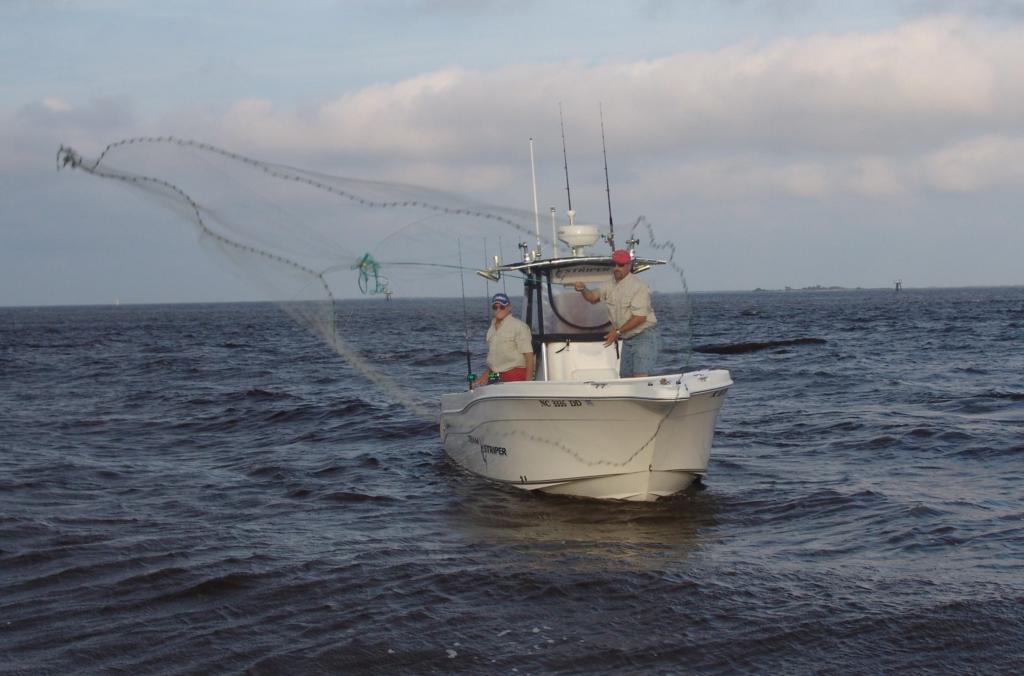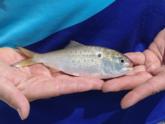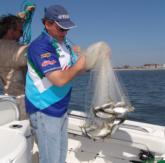Bait on the beach
Strong baitfish catch key to successful tournament for FLW Kingfish Tour anglers

For most folks, heading to the beach may mean sand castles and lots of sunscreen, but for competitors on the Wal-Mart FLW Kingfish Tour, it usually signals the beginning of a lot of hard work, the chase for elusive baitfish, cast nets and lots of slime – and that’s before the tournament even begins.
Although easily overlooked by casual fishing fans, the inescapable truth, laser-etched in the minds of FLW Kingfish Tour anglers, is this: The quest for the sport’s top prize of $100,000 starts with developing a sound strategy for catching live bait days before the start of each and every event.
While it’s true that in some areas commercial fishermen round up thousands of baitfish in holding tanks to sell to the anglers on tournament days, that isn’t always a viable or reliable option for the tournament field. And although the commercial baitfish option represents a nice convenience when available, the cost is often times prohibitive, with prices hovering around $100 or more for a dozen baitfish. Throw in the fact that bait boats are hardly a dependable option to begin with, and it becomes that much more crucial for Kingfish Tour anglers to have a do-it-yourself plan in place before they hit the marina.
“If you blow off catching bait because you plan on buying it from the bait boat, you might get up on tournament morning and find out that the bait boat’s not there or the guy ran out of bait,” said Kingfish Tour angler Van Parrish of the Jacksonville, Florida-based Team Castrol. “That’s why I hate relying on someone else for bait.”
Slimy fish can be parlayed into big dollars
For many Kingfish Tour anglers, the primary pretournament target is an oily, smelly baitfish called a menhaden – a staple in the coastal kingfish diet.
Regionally known as a “pogy,” this feisty forage fish roams the surf in large schools.
Hardier bait species like blue runners and goggle-eyes are often caught prior to the tournament, held in submerged bait pens and transferred to the boat’s livewell for competition. Penned pogies, however, easily loose their slime and suffer bruising and fatigue – all indicative of an inferior trolling presence.
 However, anglers who supplement their bait supply with other live species or dead ribbonfish still rely heavily on the acquisition of pogies – which remain the preeminent food of choice for East Coast kingfish.
However, anglers who supplement their bait supply with other live species or dead ribbonfish still rely heavily on the acquisition of pogies – which remain the preeminent food of choice for East Coast kingfish.
Why does this matter? Because anglers who learn the patterns and practices of locating and securing pogies can fill their livewells with pure kingfish candy – a necessary part of the equation for anglers who hope to share in the lucrative $300,000 tournament purse of FLW Kingfish Tour events.
In short, a successful baitfish catch can lead to big bucks in a hurry.
Strategy and awareness indispensable when hunting pogies
When menhaden run tight to the surf, kingfish boats often idle within shouting range of beachcombers. Ideally, the baitfish will show their numbers quickly, and after a couple of throws of the net, anglers can fill their livewells. But it’s rarely that simple. As a result, kingfish anglers need to develop an efficient routine that incorporates a variety of different factors such as wind, waves, water clarity and proximity of other boats.
To be sure, pogies can show up practically anywhere along an East Coast beach. Capt. Jerry Dilsaver, who heads up Team Seaswirl-Carolina Sportsman based in Oak Island, N.C., said he usually works in 8 to 12 feet of water. That’s the norm, but Dilsaver has seen both ends of the pogy spectrum.
“I prefer to catch them as shallow as possible because they are much easier to catch,” he said. “I have caught them so shallow my lower unit’s tapped between waves. The deepest I have ever caught them was 58 feet.”
As Dilsaver notes, pogy behavior is influenced by wind, swells and tides, along with temperature and barometric pressure. Savvy baitfish seekers factor all of these elements into the equation, just as they would for game fish.
“With a larger swell, they move off the beach,” Dilsaver said. “But in the fall, a northeast wind often brings them right to the beach,”
Reading the signs
Schooling pogies disclose their position by flipping at the surface. After sunrise, anglers will often see small splashes that leave rings on the water. This action also makes a distinctive sound, similar to a topwater lure hitting the surface. In warmer conditions, the flips can also serve as a guide to locating baitfish during low, predawn lighting situations.
“The sound is particularly helpful when trying to locate bait before the sun rises,” Dilsaver said. “As the weather cools, they often won’t flip until the sun shines on the water or later in the day during cloudy conditions.”
Anglers also watch up and down the beach for birds congregating over certain areas. Pogies feed more than kingfish, so anglers can take their cues from the feathered aviators and follow them to distant bait schools.
“One of the best visuals for locating bait is finding a flock of pelicans or gannets diving on them.” Dilsaver said. “With pelicans, you can often determine the size of the bait by how they swallow. With large baits, they quickly throw their heads back and swallow. With smaller baits, they hold their bill low for a while to strain the bait from the water.”
An abundance of shrimp boats can also signal pogy-catching potential. Capt. Bryan Edwards of Little River, S.C., says when he heads to the beaches, he likes seeing shrimp boats pulling their nets in shallow beach brine.
“That’s a good sign,” said Edwards, who captains the Team Kellogg’s boat, a 35-foot Yamaha-powered Wellcraft center console. “If there’s shrimp (on the beach), then the pogies should be in there, too.”
The capture
 As a teammate mans the helm, Edwards stands at the bow with his cast net loaded up and ready to throw. Using nods and shoulder shrugs to indicate direction, he tells his helmsman where he wants to go and hollers – “Neutral!” – when he needs to stop and sling the net.
As a teammate mans the helm, Edwards stands at the bow with his cast net loaded up and ready to throw. Using nods and shoulder shrugs to indicate direction, he tells his helmsman where he wants to go and hollers – “Neutral!” – when he needs to stop and sling the net.
Dilsaver offered some techniques of his own.
“Try to approach from upwind, so the wind is behind the person throwing the net,” he said. “If the bait is skittish, you can cut off the motors and let the wind push you the (remaining distance).”
Considering the size and speed of tournament-quality pogies, Dilsaver prefers the Betts Nets 22-10 or 22C-10 Super Pro cast nets. Some of the key features include 3/4-inch mesh, a 20-foot spread (10-foot radius) and 1 1/2 pounds of lead per foot of diameter. This, according to Dilsaver, yields a net that reaches over the bait, drops quickly and leaves little chance of escape.
“Some folks prefer the 12-foot version,” Dilsaver notes. “It covers more area, but doesn’t sink as quickly. I believe sinking faster is more important than coverage, especially in deeper water.”
Dilsaver’s nets come in natural and camouflage versions.
“When bait is spooky, the camo version helps minimize the flash of the net while it moves through the air,” he said.
Boat handling techniques
When netting on beaches near inlets and river channels, anglers must keep careful watch for ships and large commercial boats, as their wakes can quickly catch an unsuspecting boater off guard. Ocean swells can also wreak havoc on boats that venture into extreme shallows. That’s why coordination and clear communication between helmsman and netter is essential.
“Keeping the boat in the correct position is crucial when there’s a lot of wind,” Dilsaver said. “You must have the wind at your side or behind you to open one of the large cast nets well.
 ” border=”1″ align=”right” />“When chasing bait, it is much easier for the person throwing the net to maintain their position while moving down sea. If there is much swell and the bait is close to the beach, you must approach the bait with the boat parallel to the beach and be prepared to quickly turn and dart offshore.”
” border=”1″ align=”right” />“When chasing bait, it is much easier for the person throwing the net to maintain their position while moving down sea. If there is much swell and the bait is close to the beach, you must approach the bait with the boat parallel to the beach and be prepared to quickly turn and dart offshore.”
However, these days, rare is the morning that a kingfish team enjoys solo access to a herd of pogies. Typically, several boats end up working the same stretch of beach, and courteous sensibility helps ensure full livewells for all.
“As the water gets deeper, the bait is usually less skittish, and you can move in on them pretty aggressively,” Dilsaver said. “Sometimes, even in shallow water, it is a matter of being aggressive, working your way in on the bait and catching some before it spooks.
“If other boats have been on the bait for a while when you arrive, moving in very easily and paying close attention can help a lot. It is a matter of respect to move in slowly on (an area) someone else has located. By watching it for a while, you can tell if it is moving or not.”
Also, the pressure of too much boat traffic and too many cast nets will eventually force the bait schools down or drive them out of the area. However, experienced anglers know that pogies won’t run far. Consequently, anglers can usually rely on a quick scan of the beach or diving birds to relocate the school in a pinch.
“When working around other boats, it is always wise to have someone looking around a little farther away,” Dilsaver said. “If the bait goes down and pops up somewhere else, you might be the first to get on them.
“Always remember that the tide tends to move schools of bait in and out. If they aren’t where you think they should be, they may be a little down current from there.”
Whenever possible, anglers try to drop their bait directly into the livewell. But if that’s not feasible, the next best thing is to drop them into a bucket or a plastic bin filled with water. This softens the impact, prevents the baits from losing much of their slime and keeps them in better shape for fishing.
Which, after all, is the reason behind the hunt in the first place.